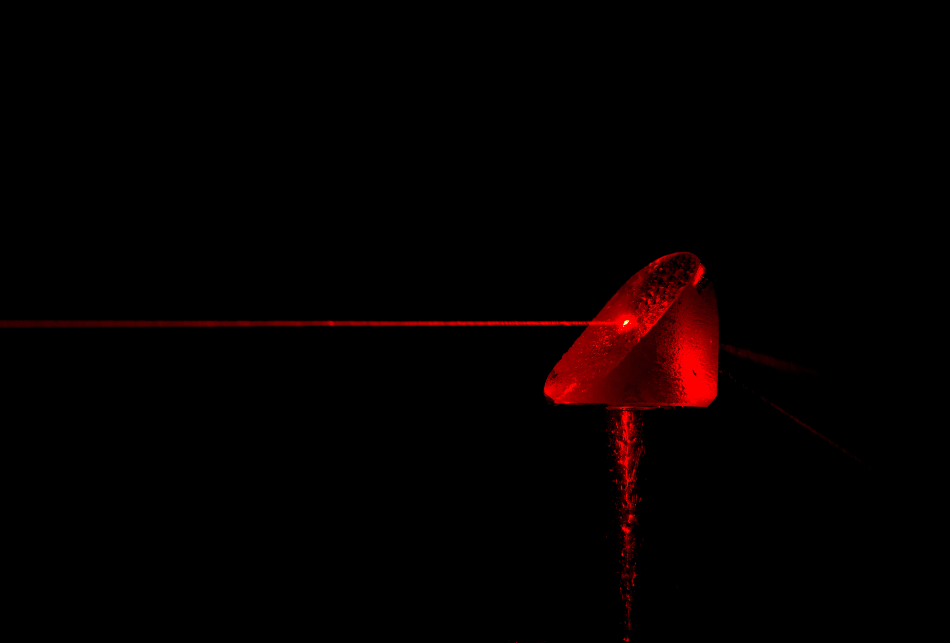
Image Credit: Doug McLean/Shutterstock.com
The ablation of materials with a laser is a common technique in laser machining and laser drilling applications. Laser ablation is the process of removing small amounts of material from bulk material to either create smaller fragments or to generate holes in a material. Most laser ablation processes are performed on a solid material in a vacuum environment, but a different method has emerged which ablates solid materials submerged in a liquid into nanomaterial dispersions. This method is known as laser ablation in a liquid environment (LALE) or pulsed laser ablation in liquid (PLAL).
The basic process of any ablation method is straightforward. The bulk material absorbs the laser energy, and parts of the material evaporate, sublimate or remove themselves from the bulk material. This is dependent upon the laser flux, materials, environment, and other factors.
The method is often controlled, so only the desired amount of energy is inputted into the material. This is important for the more precise methods that look to remove a small amount of the bulk material.
History of LALE
While ablating materials in a vacuum is the most popular ablating method, LALE is an effective technique for certain scenarios. The basis for LALE comes from the pulsed laser ablation technique.
Pulsed laser ablation fires very quick and short laser pulses at the material, so the material surrounding the absorption zone only absorbs a little heat at any given time. This means that a small amount of material is removed at a time, making it a very controlled method. Pulsed laser ablation methods were then adapted into pulsed laser deposition (PLD) methods, which ablated materials in an evacuated deposition chamber using vacuum and gaseous environments.
The LALE Method
In the LALE method, the laser beam interacts with both the solid material and the solvent simultaneously, causing a plasma plume to form and expand within the liquid.
Plasmas can form in the gaseous-vacuum environments of PLD methods, but the liquid causes the plasma to be confined to the area of the liquid only. The process causes the temperature to reach anywhere between 4000 and 5000 K, and the density of ablated species can reach anywhere between 1022–1023 cm3, with pressures up to 10 GPa.
The ablated species then act in one of two ways. The first is that bubbles oscillate out from the plasma, carrying the ablated species (i.e., nanoparticles), at which point they disperse into the liquid medium when the bubble collapses. The second is that they undergo specific chemical reactions at the interface between the plasma and the liquid, which enables functionalized nanomaterials to be created.
Benefits of LALE
The controlled pulses of the lasers used mean that small amounts of materials can be broken off a bulk material and then these smaller fragments can enter the liquid medium and disperse in it. For this reason, it has become an efficient technique for breaking bulk materials down in a controlled fashion into colloidal suspensions and nanoparticle dispersions. As well as dispersing particles, it is a technique that can be used to prepare a range of nanostructured materials with differing compositions, morphologies, and phases.
One of the key features is that the dispersant medium and the raw material are in one place, and once the material has been broken down into smaller chunks, the dispersion is ready to be used. This is different to other ablation methods in which the solid needs to be removed and either dispersed, treated, or purified. For this reason, no purification stages are needed.
LALE does not produce waste and is a chemically clean method. It is also a one-pot synthesis reaction for certain nanostructured (and functionalized nanostructured) materials. This is an excellent development for the synthesis of some nanomaterials, as there is a movement to remove nanomaterial-based waste from production processes because of the potential for it to be hazardous to both humans and the environment.
Compared to other material preparation methods, LALE is relatively low in cost, has few parameters that need to be controlled and accounted for, a high yield, and can be used with materials that traditionally have unstable metaphases. However, at the moment, its use is limited in terms of the materials that can be prepared. Metal oxides, metals colloids, semiconductors, quantum dots, and nitrites are currently the most common materials that can be prepared by LALE Methods.
References and Further Reading
- “Laser Ablation in Liquid: An Unconventional, Fast, Clean and Straightforward Technique for Material Preparation”- Mendes de Azevedo W. et al., Applications of Laser Ablation - Thin Film Deposition, Nanomaterial Synthesis and Surface Modification, DOI: 10.5772/66245
- “Pulsed laser ablation of bulk target and particle products in liquid for nanomaterial fabrication”- Lai J. et al., AIP Advances, 2019, DOI: 10.1063/1.5082695
Disclaimer: The views expressed here are those of the author expressed in their private capacity and do not necessarily represent the views of AZoM.com Limited T/A AZoNetwork the owner and operator of this website. This disclaimer forms part of the Terms and conditions of use of this website.